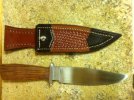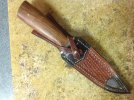David Bates
Knifemaker/service provider
- Joined
- Mar 11, 2013
- Messages
- 95
This is sheath #14 for me so I figured why not give it a try. My first time doing an overlay (used pig skin) because I don't have a splitter or 2oz leather. I also add a Sam brown button and a bow tie. Hand stitched and my first sheath type with integrated belt loop. It's no where near what I have seen on this forum but hopefully you'll see improvement in the future. Your feedback is appreciated.


David


David
